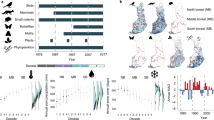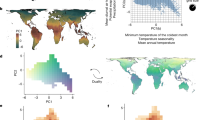Abstract
Climate has been routinely indicated as a major determinant of broad-scale species richness patterns for a variety of taxa, but studies vary widely in attributing richness variation to the broad-scale distribution of energy, water, ecosystem productivity, habitat heterogeneity, or some combination thereof. Here, I report global and regional environment–richness relationships for the four classes of terrestrial vertebrates (mammals, birds, reptiles, amphibians) using identical sample units and the same set of climate (temperature, precipitation, annual actual evapotranspiration), productivity (normalized difference vegetation index), and topographic (elevation range) variables. My results strongly support concomitant availability of energy and water as the principal constraint on global richness for all vertebrate groups except reptiles, which are largely constrained by temperature. However, environment–richness models for all taxonomic groups varied widely when applied to single (continental-scale) biogeographic realms. In particular, I found strong support for the ‘water–energy dynamics hypothesis’ that models richness as a function of ambient energy (temperature) in high latitudes and water availability (precipitation) at low latitudes, partially independent of productivity. Ectotherm groups were more constrained by temperature than endotherms, and amphibians were more constrained by water availability than other groups. Although habitat heterogeneity, measured as elevation range, was a consistent contributor to global and regional richness models for all groups, its contribution was always minor compared to other variables. I conclude that temperature and water availability are key variables for modeling broad-scale vertebrate richness, but there remains significant room for taxon-specific modeling approaches and for the inclusion of non-climate factors related to evolutionary history and faunal assembly in different regions.


Similar content being viewed by others
References
Ahn C-H, Tateishi R (1994) Development of a global 30-minute grid potential evapotranspiration data set. Photogramm Remote Sensing 33:12–21
Badgley C, Fox DL (2000) Ecological biogeography of North American mammals: species density and ecological structure in relation to environmental gradients. J Biogeogr 27:1437–1467
Buckley LB, Jetz W (2007) Environmental and historical constraints on global patterns of amphibian richness. Proc R Soc Lond B 274:1167–1173
Burnham KP, Anderson DR (2002) Model selection and multimodel inference. Springer, Berlin Heidelberg New York
CC IP (2007) Climate change 2007—the physical science basis. Cambridge University Press, Cambridge, UK
Cliff AD, Ord JK (1981) Spatial processes: models and applications. Pion, London
Currie DJ (1991) Energy and large-scale patterns of animal species and plant species richness. Am Nat 137:27–49
Davies RG, Orme CDL, Storch D, Olson VA, Thomas GH, Ross SG, Ding T-S, Rasmussen PC, Bennett PM, Owens IPF, Blackburn TM, Gaston KJ (2007) Topography, energy and the global distribution of bird species richness. Proc R Soc Lond B 274:1189–1197
Davis ALV, Scholtz CH (2001) Historical vs. ecological factors influencing global patterns of scarabaeine dung beetle diversity. Divers Distrib 7:161–174
Ding T-S, Yuan H-W, Geng S, Koh C-N, Lee P-F (2006) Macro-scale bird species richness patterns of the East Asian mainland and islands: energy, area and isolation. J Biogeogr 33:683–693
Diniz-Filho JAF, Bini LM, Hawkins BA (2003) Spatial autocorrelation and red herrings in geographical ecology. Glob Ecol Biogeogr 12:53–64
Dormann CF (2007) Effects of incorporating spatial autocorrelation into the analysis of species distribution data. Glob Ecol Biogeogr 16:129–138
Dormann CF, McPherson JM, Araújo MB, Bivand R, Bolliger J, Carl G, Davies RG, Hirzel A, Jetz W, Kissling WD, Kühn I, Ohlemüller R, Peres-Neto PR, Reineking B, Schröder B, Schurr FM, Wilson R (2007) Methods to account for spatial autocorrelation in the analysis of species distributional data: a review. Ecography 30:609–628
Evans KL, James NA, Gaston KJ (2006) Abundance, species richness and energy availability in the North American avifauna. Glob Ecol Biogeogr 15:372–385
Francis AP, Currie DJ (1998) Global patterns of tree species richness in moist forests: another look. Oikos 81:598–602
Francis AP, Currie DJ (2003) A globally consistent richness–climate relationship for angiosperms. Am Nat 161:523–536
Hawkins BA, Porter EE (2003) Water-energy balance and the geographic pattern of species richness of western Palearctic butterflies. Ecol Entomol 28:678–686
Hawkins BA, Field R, Cornell HV, Currie DJ, Guégan J-F, Kaufman DM, Kerr JT, Mittelbach GG, Oberdorff T, O’Brien EM, Porter EE, Turner JRG (2003a) Energy, water, and broad-scale geographic patterns of species richness. Ecology 84:3105–3117
Hawkins BA, Porter ER, Diniz-Filho JAF (2003b) Productivity and history as predictors of the latitudinal diversity gradient of terrestrial birds. Ecology 84:1608–1623
Hawkins BA, Diniz-Filho JAF, Jaramillo CA, Soeller SA (2007a) Climate, niche conservatism, and the global bird diversity gradient. Am Nat 170:S16–S27
Hawkins BA, Diniz-Filho JAF, Bini LM, Marco PD, Blackburn TM (2007b) Red herrings revisited: spatial autocorrelation and parameter estimation in geographical ecology. Ecography 30:375–384
He K, Zhang J (2009) Testing the correlation between beta diversity and differences in productivity among global ecoregions, biomes, and biogeographical realms. Ecol Inform 4:93–98
Hortal J, Rodríguez J, Nieto-Díaz M, Lobo JM (2008) Regional and environmental effects on the species richness of mammal assemblages. J Biogeogr 35:1202–1214
Hurlbert AH (2004) Species–energy relationships and habitat complexity in bird communities. Ecol Lett 7:714–720
Hurlbert AH, Haskell JP (2003) The effect of energy and seasonality on avian species richness and community composition. Am Nat 161:83–97
Huston MA (1994) Biological diversity: the coexistence of species on changing landscapes. Cambridge University Press, Cambridge
ISLSCP (International Satellite Land-Surface Climatology Project) Initiative II (2004) Fourier-adjusted, sensor and solar zenith angle corrected, interpolated, reconstructed (FASIR) adjusted normalized difference vegetation index (NDVI), Version 4.13. http://islscp2.sesda.com/ISLSCP2_1/html_pages/groups/veg/fasir_ndvi_monthly_xdeg.html
Janzen DH (1967) Why mountain passes are higher in the tropics. Am Nat 101:233–249
Kalmar A, Currie DJ (2006) A global model of island biogeography. Glob Ecol Biogeogr 15:72–81
Kalmar A, Currie DJ (2007) A unified model of avian species richness on islands and continents. Ecology 88:1309–1321
Kerr JT, Packer L (1997) Habitat heterogeneity as a determinant of mammal species richness in high-energy regions. Nature 385:252–254
Kreft H, Jetz W (2007) Global patterns and determinants of vascular plant diversity. Proc Natl Acad Sci USA 104:5925–5930
Kühn I (2007) Incorporating spatial autocorrelation may invert observed patterns. Divers Distrib 13:66–69
Lamoreux JF, Morrison JC, Ricketts TH, Olson DM, Dinerstein E, McKnight MW, Shugart HH (2006) Global tests of biodiversity concordance and the importance of endemism. Nature 440:212–214
Latham RE, Ricklefs RE (1993) Global patterns of tree species richness in moist forests: energy-diversity theory does not account for variation in species richness. Oikos 67:325–333
MacArthur RH (1972) Geographical ecology: patterns in the distribution of species. Harper and Row, New York
New M, Hulme M, Jones P (1999) Representing twentieth-century space-time climate variability. Part I: Development of a 1961-90 mean monthly terrestrial climatology. J Clim 12:829–856
O’Brien EM (1998) Water-energy dynamics, climate, and prediction of woody plant species richness: an interim general model. J Biogeogr 25:379–398
O’Brien EM, Field R, Whittaker RJ (2000) Climatic gradients in woody plant (tree and shrub) diversity: water-energy dynamics, residual variation, and topography. Oikos 89:588–600
Qian H (2008) Effects of historical and contemporary factors on global patterns in avian species richness. J Biogeogr 35:1362–1373
Qian H (2009) Global tests of regional effect on species richness of vascular plants and terrestrial vertebrates. Ecography 32:553–560
Qian H, Ricklefs RE (1999) A comparison of the taxonomic richness of vascular plants in China and the United States. Am Nat 154:160–181
Qian H, Ricklefs RE (2000) Large-scale processes and the Asian bias in species diversity of temperate plants. Nature 407:180–182
Qian H, Ricklefs RE (2008) Global concordance in diversity patterns of vascular plants and terrestrial vertebrates. Ecol Lett 11:547–553
Qian H, Wang X, Wang S, Li Y (2007a) Environmental determinants of amphibian and reptile species richness in China. Ecography 30:471–482
Qian H, White PS, Song J-S (2007b) Effects of regional vs. ecological factors on plant species richness: an intercontinental analysis. Ecology 88:1440–1453
Rahbek C, Graves GR (2001) Multiscale assessment of patterns of avian species richness. Proc Natl Acad Sci USA 98:4534–4539
Richerson PJ, Lum K (1980) Patterns of plant species diversity in California: relation to weather and topography. Am Nat 116:504–536
Ricklefs RE, Qian H, White PS (2004) The region effect on mesoscale plant species richness between eastern Asia and eastern North America. Ecography 27:129–136
Rosenzweig ML (1968) Net primary productivity of terrestrial communities: prediction from climatological data. Am Nat 102:67–74
Rosenzweig ML (1995) Species diversity in space and time. Cambridge University Press, Cambridge
Storch D, Davies RG, Zajícek S, Orme CDL, Olson V, Thomas GH, Ding T-S, Rasmussen PC, Ridgely RS, Bennett PM, Blackburn TM, Owens IPF, Gaston KJ (2006) Energy, range dynamics and global species richness patterns: reconciling mid-domain effects and environmental determinants of avian diversity. Ecol Lett 9:1308–1320
Thomas GH, Orme CDL, Davies RG, Olson VA, Bennett PM, Gaston KJ, Owens IPF, Blackburn TM (2008) Regional variation in the historical components of global avian species richness. Glob Ecol Biogeogr 17:340–351
Turner JRG, Hawkins BA (2004) The global diversity gradient. In: Lomolino MV, Heaney LR (eds) Frontiers of biogeography: new directions in the geography of nature. Sinauer, Sunderland, pp 171–190
Turner JR, Gatehouse CM, Corey CA (1987) Does solar energy control organic diversity? butterflies, moths and the British climate. Oikos 48:195–205
Turner JRG, Lennon JJ, Lawrenson JA (1988) British bird species distributions and energy theory. Nature 335:539–541
US Geological Survey (USGS) National Center for Earth Resources Observation & Science (2003) Global 30-arc-second elevation data set (GTOPO30). http://edcdaac.usgs.gov/gtopo30/gtopo30.asp
Whittaker RJ, Nogués-Bravo D, Araújo MB et al (2007) Geographical gradients of species richness: a test of the water-energy conjecture of Hawkins. (2003) using European data for five taxa. Glob Ecol Biogeogr 16:76–89
Willig MR, Kaufman DM, Stevens RD (2003) Latitudinal gradients in biodiversity: pattern, process, scale, and synthesis. Annu Rev Ecol Evol Syst 34:273–309
World Wildlife Fund (2006) WildFinder: Online database of species distributions, ver. Jan-06. http://www.worldwildlife.org/wildfinder
Wright DH (1983) Species-energy theory: an extension of species-area theory. Oikos 41:496–506
Acknowledgments
I thank Jason Fridley for his contribution to the writing of the manuscript, and anonymous reviewers for their constructive and helpful comments.
Author information
Authors and Affiliations
Corresponding author
Electronic supplementary material
Below is the link to the electronic supplementary material.
About this article
Cite this article
Qian, H. Environment–richness relationships for mammals, birds, reptiles, and amphibians at global and regional scales. Ecol Res 25, 629–637 (2010). https://doi.org/10.1007/s11284-010-0695-1
Received:
Accepted:
Published:
Issue Date:
DOI: https://doi.org/10.1007/s11284-010-0695-1




